Four comets, a famous variable star, and sprinkles of dust from Halley's Comet (which create the Orionid meteor shower) are highlights of the October sky.
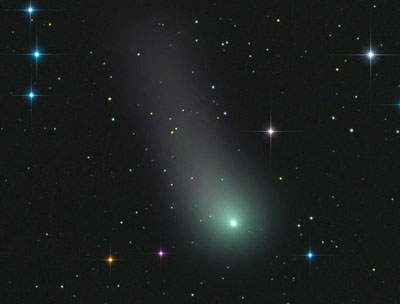
Rolando Ligustri
I hope you had the opportunity to observe C/2018 W2 (Africano), the brightest comet of the summer and fall. It peaked around 9th magnitude earlier this month while speeding through Pisces after making its closest approach to Earth on September 27th. I saw it last on October 3rd before the Moon interfered. In my 15-inch at 64× magnification, the comet's moderately condensed coma measured about 3′ across with a stubby tail pointing to the northeast. Photographs reveal green carbon emission, a bright pseudo-nucleus and smear of a tail.
Comet Africano continues to clip southward. This week and next it slices across Piscis Austrinus before dropping out of view for observers at mid-northern latitudes. The comet will also fade from its current magnitude of 9.5 to the mid-10s by late October, so catch it the next clear night. Moonless skies return as soon as tonight, with best viewing times between 8 and 11 p.m. local time.
Faint Fall Comets
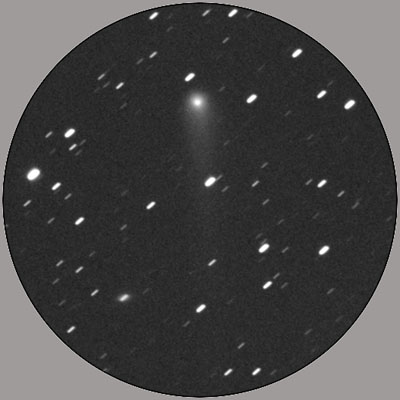
Alfons Diepvens
Three additional comets ply the fall skies, and all are visible in 10-inch and larger telescopes: C/2018 N2 (ASASSN), 260P/McNaught, and C/2017 T2 (PanSTARRS).
C/2018 N2 proved a pleasant surprise at 142× on October 7th with a strongly condensed (DC=6) coma 1.5′ across. With averted vision and 245× I teased out a faint, 14th-magnitude stellar nucleus and suspected a ~1.5′ tail to the south. Given its high DC and overall magnitude of 11.5, an 8-inch scope under dark skies should nail this one.
Closest approach to Earth occurs on October 20th followed by perihelion on November 10th, so this celestial Q-tip will be easy to follow throughout the fall as it brightens a smidge through late October. If you're looking for the perfect time to find it, C/2018 N2 will pass within 1° of 2nd-magnitude Beta (β) Andromedae on October 19-20 and 3° southwest of the Andromeda Galaxy on November 2nd.
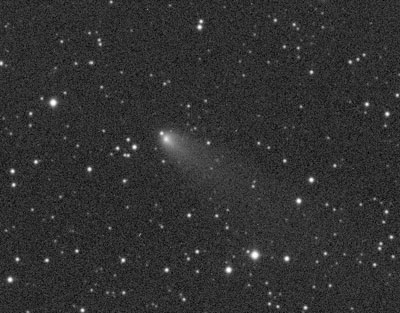
Martin Mobberley
260P/McNaught, another minnow of a comet, spends October wriggling northeastward across Perseus. On October 7th, it glowed at magnitude 12 but was easy to see even at low magnification because of its small size — just 1′ across — and compact (DC=5) coma. You'd think a 12th-magnitude comet wouldn't show a tail, but it was surprisingly easy to spy with averted vision as a 1.5′ long streak pointing southwest. I estimated the false stellar nucleus at magnitude 13.5. Even as 260P slowly fades this month it remains well-placed for viewing from mid-northern latitudes throughout the fall.
C/2017 T2 (PanSTARRS) is expected to be the main act for comets in 2020, as it's expected to brighten to magnitude 8 by next May. For now, it slumbers around magnitude 12.5 while inching northwestward through the open cluster-rich region of central Auriga. On the nights of October 27th and 28th, the comet ambled up alongside the bright open cluster M36, some 20′ east of its core. While the previous three comets are visible at nightfall, C/2017 T2 doesn't climb high enough for a good look until after 11 o'clock local time (10 p.m. by end of month). Be aware that the Moon will interfere until Oct. 20.
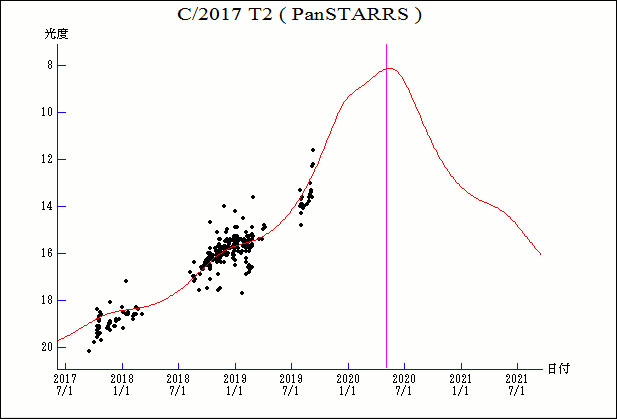
Seiichi Yoshida
On October 7th, PanSTARRS sported a small, dense 45″ coma with a DC=6 at 142×. Upping to 245× I noted a nearly opaque inner coma with a 15th-magnitude flicker of a nucleus. I applied a Swan Band filter on this and the other three comets, but none showed an improvement in contrast or brightness — an indication that the whole lot are relatively rich in dust compared to fluorescing diatomic carbon gas, one of the substances that causes comas to glow green.
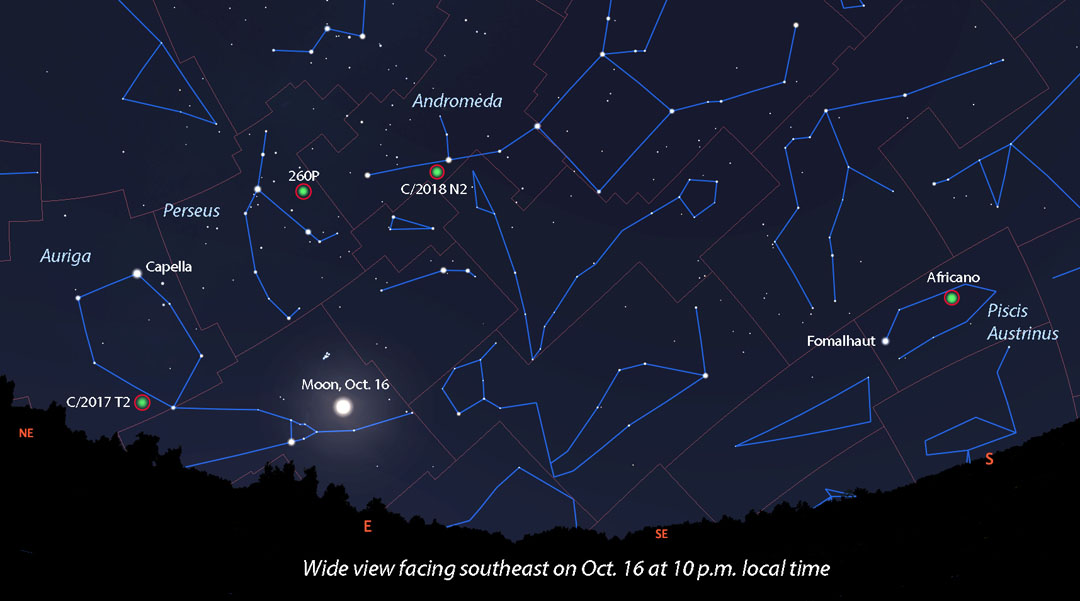
Stellarium
Below you'll find detailed maps created with SkyMap to track each of our four visitors over the next few weeks. The wide-field map above will give you an idea of when and where to start looking. North is up in all charts and positions are shown daily at 0 hours UT. Subtract 4 hours for EDT, 5 for CDT, 6 for MDT and 7 for PDT. For example: October 20, 0h UT = October 19, 8 p.m. EST.
C/2018 W2 (Africano)
C/2018 N2 (ASASSN)
260P/McNaught
C/2017 T2 (PanSTARRS)
You might be wondering what's up with interstellar comet 2I/Borisov. It remains very faint at around magnitude 16. I've heard of no amateur visual sightings, though it's increasingly showing up in astrophotos. We'll check in with this alien visitor again in December when it's closer to perihelion. I've still got my fingers crossed amateurs will spot it in bigger instruments around the time of its December perihelion.

Michael Jäger
Under Mira's Eye
I like to picture all these comets wending their ways under the watchful eye of Mira the Wonderful, one of the best known and beloved variable stars. The brightness of the red giant star varies over a period of about 333 days and is just now coming into good view, while simultaneously experiencing one of its brighter maxima. With a current magnitude of about 2.9, you can't miss it! Especially when this weekend's full moon departs the scene. Will you be able to detect the star's ruddy hue with the naked eye? I know it's visible in my binoculars.
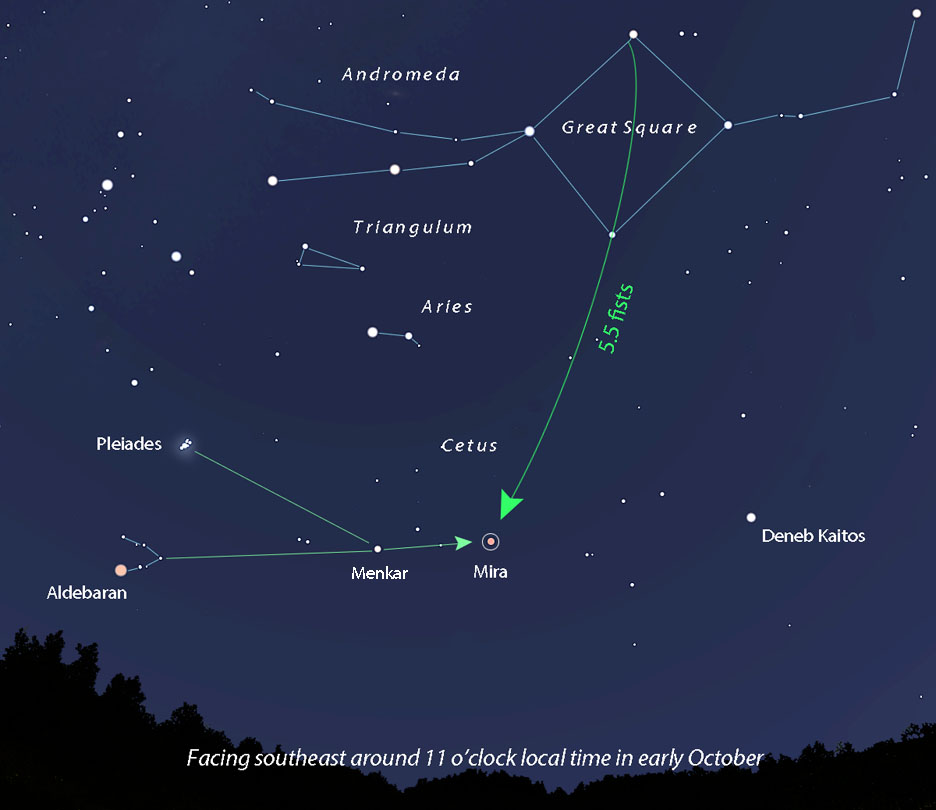
Stellarium
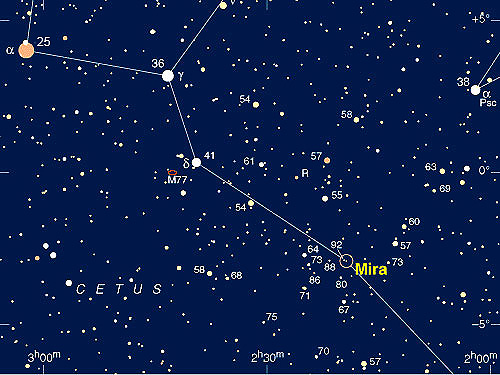
Mira's peak brightness varies from cycle to cycle, but right now it's at or near maximum. Keep an eye on it and you can watch it slowly return to minimum brightness over the coming months. The chart above will help you estimate the Mira's changing brightness.
Orionid Meteor Shower
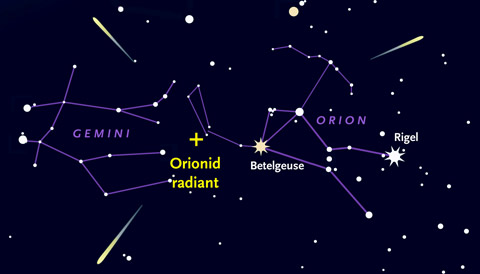
Sky & Telescope illustration
Hmm ... what else would spice up late October skygazing? How about a nice little meteor shower? The annual Orionids peak on the night of October 21-22 (that is, Monday night through Tuesday morning), with 15-20 swift meteors visible per hour from a dark, moonless sky. Each crumble of rock or mote of dust flashing before your eyes is a souvenir from Halley's Comet. Although the waning last-quarter Moon (42% illuminated) will interfere, it's not so bright as to call off spending a relaxing hour before dawn watching meteors fly. You might even try your luck from 11:30 to 12:30 before moonrise when Orion first appears in the east.
 17
17









Comments
Chris-Schur
October 17, 2019 at 6:17 pm
Bob, what does the spectrum of mira do at maximum?
You must be logged in to post a comment.
Bob KingPost Author
October 22, 2019 at 11:23 pm
Hi Chris,
I know that it has the most amazingly rich spectrum of any star I've ever seen. Many bands visible in a budget Rainbow Optics model.
You must be logged in to post a comment.
Bill -Simpson
October 17, 2019 at 11:58 pm
Great video and charts.
You must be logged in to post a comment.
Bob KingPost Author
October 22, 2019 at 11:19 pm
Hi Bill,
Really appreciate that, thanks!
You must be logged in to post a comment.
Dan
October 19, 2019 at 12:37 am
Hi Bob,
Caught three of your four comets on the night of Sept30-Oct 01 in a RASA 11 and animated the lot. Comet Klemola was the fourth four the night-small and hard to see against M16.
Animation here if interested. https://youtu.be/BXGi500ORII
I always enjoy your column
Dan
You must be logged in to post a comment.
Bob KingPost Author
October 22, 2019 at 11:18 pm
Hi Daniel,
Wow! Nice. Thanks for the link. I left Klemola out because of altitude and faintness. I got a good view of it in August in Ophiuchus.
You must be logged in to post a comment.
Rod
October 19, 2019 at 11:37 am
Bob King et al. Last night I was out under the stars from 2200-2330 EDT. Waning gibbous Moon rose near 2142 EDT. I was viewing the Pleiades (M45) cluster in Taurus at 25x using my 90-mm refractor. Suddenly, a meteor flashed by in the field of view, this was near 2300 EDT. Perhaps I caught a quick view of an Orionid streaking by 🙂 During my observing, some geese were flying high above me, heading south, honking along the way. Someone is using star patterns I suspect in late night migration flights 🙂 I have observed this a number of times where I live along the Patuxent river farms in Maryland when I am out stargazing, especially in Fall and Spring (heading north then).
You must be logged in to post a comment.
Bob KingPost Author
October 22, 2019 at 11:17 pm
Hi Rod,
Birds absolutely use stars as well as Earth's magnetic field during migration.
You must be logged in to post a comment.
OwlEye
October 22, 2019 at 2:32 pm
Hi Bob,
The first time I observed the Orionids was back in 1971 - had two perfectly clear mornings at the maximum in my grandparents back yard, just across the street from the southernmost part of Leslie Peltier's south woods in Delphos, Ohio. This morning, between 4:50 and 6:23 am, CDT, and amidst a strong October wind, I saw two shower members from a rather restricted portion of the sky visible from my deck, at 5:19 and 6:15 am. The latter meteor cut through the Hyades - very close to Aldebaran - and was first magnitude, orange, and left a glittering train that lasted one second.
Regards,
Doug Z
AAVSO
TWAN
You must be logged in to post a comment.
Bob KingPost Author
October 22, 2019 at 11:16 pm
Hi Doug,
Thanks for sending in your observations. That makes two more meteors than I saw. (We had clouds and rain).
You must be logged in to post a comment.
OwlEye
October 23, 2019 at 10:58 am
Sorry to hear that, Bob. I am sure you have experienced many Orionid showers - could you please tell us about your most memorable one?
Regards,
Doug Z
You must be logged in to post a comment.
George Gliba
October 23, 2019 at 1:16 pm
Hey Bob,
This morning I was observing meteors up in the mountains of West Virginia at Screech Owl Hill
Observatory in Mathias. I got some pretty good results when I saw a total of 32 meteors with
mostly clear skies and with an average LM=6.2 from 4:30 - 6:30 UT. Of these 15 were Orionids;
the best of which was a beautiful blue-green one at 5:31 UT of -1 magnitude. Average brightness
for the Orionds was 2nd magnitude and half of them left a persistent train.
Starry Skies,
GWG
You must be logged in to post a comment.
Bob KingPost Author
October 24, 2019 at 10:34 am
Hi George,
Excellent report. Glad the shower was as active as expected. PS. I'm a little jealous — maybe next year!
You must be logged in to post a comment.
Joe Stieber
October 24, 2019 at 4:09 pm
I was out to the NJ Pines for three-quarters of an hour this morning (about 12:30 to 1:15 am EDT on 24-October-2019) and didn’t see a single meteor; however, I wasn’t focused on them. Mainly, I wanted to take a look at Mira (and get a snapshot) under a dark sky while it was near it’s peak brightness.
I first looked intentionally at Mira for this cycle on October 11 from my suburban back yard with a nearly-full moon in the sky. It was easy to see in binoculars, and with effort (and while blocking the moon with my hand at the end of an outstretched arm), I could see Mira with unaided eyes.
What a difference a dark, moon-free sky makes! Mira was easy with unaided eyes this morning, although I didn’t perceive and real color. I did see a mild yellow-reddish color in my 15x56 binoculars, ditto for nearby Menkar (for reference, R Leporis showed a deep red color in the binos). Click on my name (next to the avatar) for a snapshot of Mira this morning — the color shows well (without using processing tricks).
BTW, I usually find Mira by starting at easy-to-see Aries. A line from Hamal through Sheratan leads to Eta Piscium in the eastern rope of Pisces. I slide down the rope to Alrischa (the knot in the ropes) then jump down 7 degrees to Mira. This is a binocular path in a suburban sky (especially under moonlight), but works with unaided eyes from a dark site. There’s also a distinctive shallow arc passing through two pairs of stars between Alrischa and Mira for confirmation in binoculars.
You must be logged in to post a comment.
OwlEye
October 25, 2019 at 12:43 pm
Nicely written, Joe.
DZ
You must be logged in to post a comment.
Bob KingPost Author
October 26, 2019 at 10:11 am
Thank you, OwlEye. Much appreciated.
You must be logged in to post a comment.
Joe Stieber
October 26, 2019 at 4:48 pm
Thanks Doug!
You must be logged in to post a comment.
You must be logged in to post a comment.